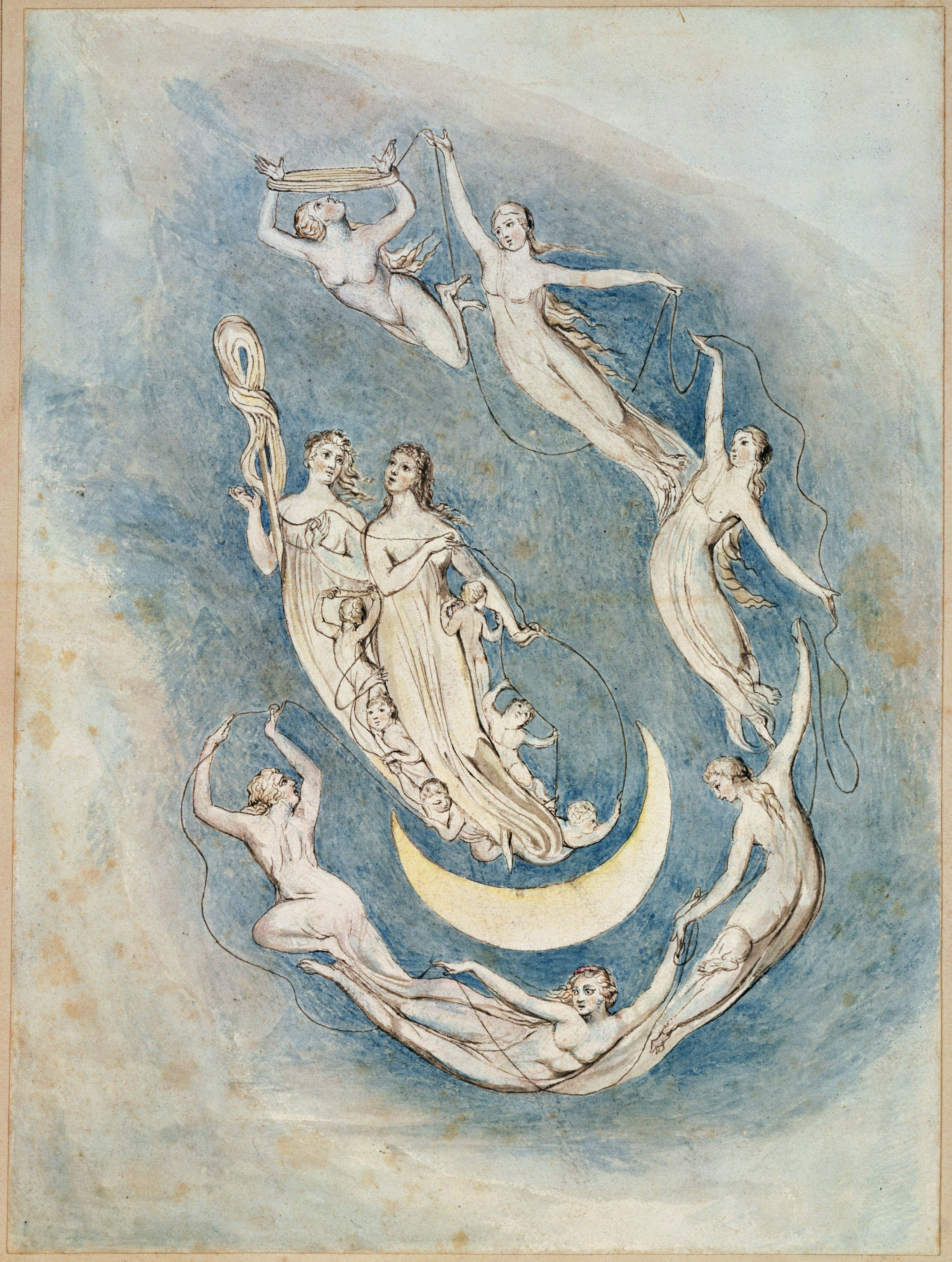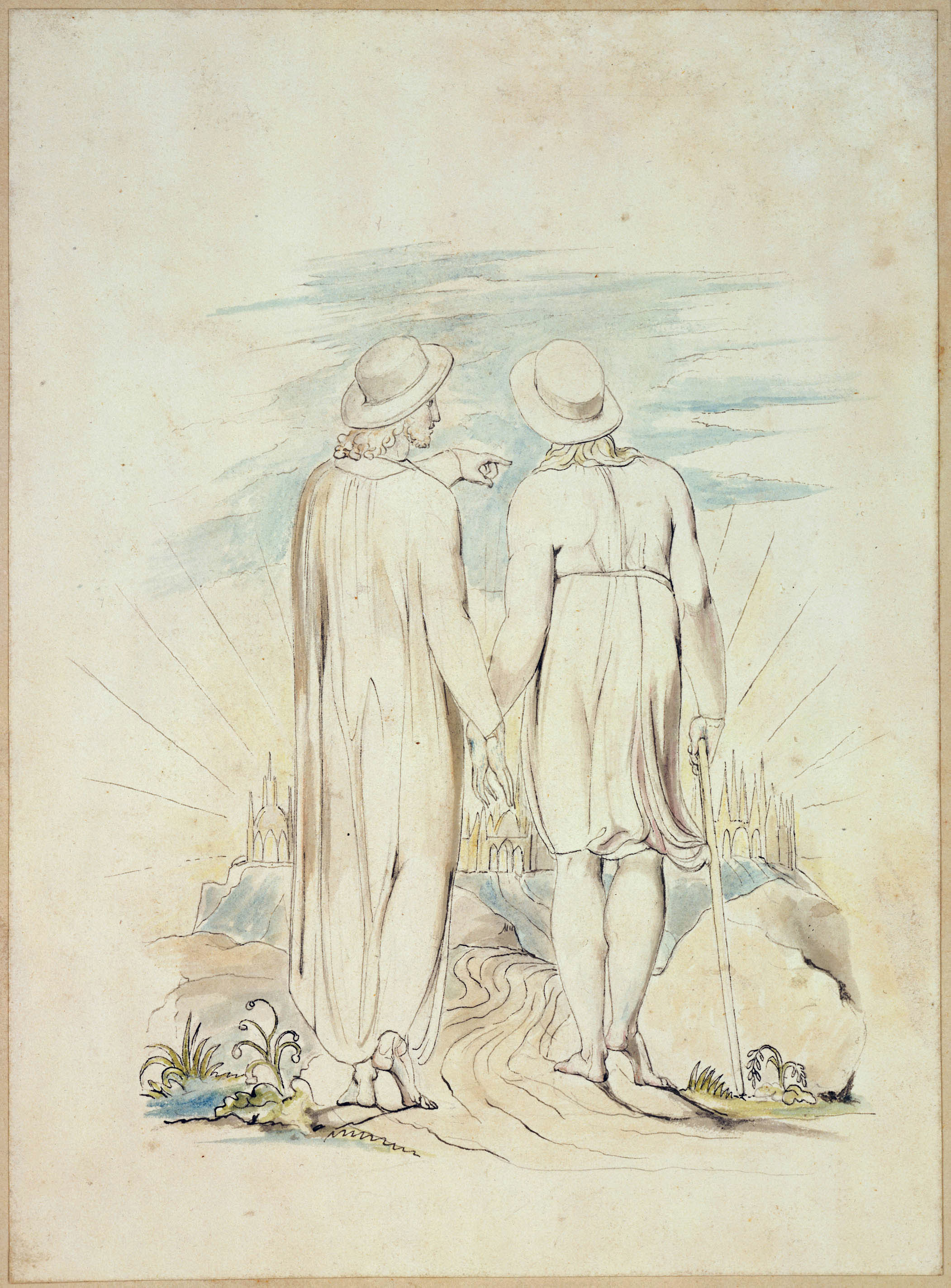MINUTE PARTICULARS
“Friendship,” Love, and Sympathy in Blake’s Grave Illustrations
In his essay announcing the very exciting discovery of Blake’s original designs for Robert Blair’s poem The Grave, Martin Butlin describes one of them as depicting “eight exquisite airborne female figures, two, accompanied by six cherubs, rising above a crescent moon, while the others soar up and encircle them; together they hold the thread of life.” He adds, “This allusion to the Fates is presumably based on the line, in the midst of a long passage on the horrors of suicide on page 18, that reads ‘Our Time is fix’d, and all our days are number’d!’” (71). The design, which was not one of those engraved and published in Cromek’s 1808 edition of the poem, is reproduced here as illus. 1; I have seen only this image, for the pictures themselves are not presently accessible.1↤ 1. Nathan Winter of Dominic Winter Book Auctions provided helpful advice. For some news on the watercolors, see Goodwin.
Butlin’s hypothesis about the subject of the design responds in part to the prominent motif of thread being spun and passed between female figures, which resembles the way Clotho, Lachesis and Atropos spin and pass the thread of life between them in traditional representations of the course of mortal life. Versions of this motif can be found in several of Blake’s designs, including the “Arlington Court Picture” (a.k.a. “The Sea of Time and Space,” Butlin, Painting and Drawings no. 803) and his illustrations to Gray and Milton. But that particular thread-passing usually ends when Atropos takes her cruel shears and fatally snips the thread—in this design, by contrast, the penultimate woman helps the topmost figure wind the thread in traditional fashion onto a large skein on her wrists, and no cutting tools are in evidence.
Several lines of Blair’s poem that appear on pages 4 and 5 of the 1808 edition fit the illustration more closely than the passage about suicide on page 18:
Invidious Grave! How dost thou rend in sunderThe left figure within the arc of the moon is probably Sympathy, holding a distaff wound with raw material begin page 101 | ↑ back to top
Whom love has knit, and sympathy made one!
A tie more stubborn far than nature’s band.
Friendship! Mysterious cement of the soul!
[P. 5] Sweet’ner of life! And solder of society!
I owe thee much.

[View this object in the William Blake Archive]
Blair’s exclamation, “Invidious Grave! How dost thou rend in sunder / Whom love has knit, and sympathy made one!” laments the fact that friends bound together by love can be parted by death. The text is ambiguous about the extent of the rupture between living and dead friends, but Blake’s design contains no hint that the Grave could never break the more durable bond of friendship. The picture as a whole seems to be a straightforward celebration of friendship, love, and sympathy, even if there are reasons to suspect that Blake thought of them all as mere shadows of a greater love. Female love, female beauty, and the textile arts (especially weaving) are sometimes represented in Blake as potentially delusive, blinding, or binding, and are associated with the seductive charms and limitations of the natural world as opposed to the sublime glories of the spiritual realm. Since spinning and its correlatives are the postlapsarian business of Eve and her daughters, spinning in Blake sometimes seems a fallen activity, productive and even satisfying but not in itself redemptive. Nevertheless, I find little that could be seen as sinister in this design, which suggests that the difference between corporeal and spiritual friendship is one of degree rather than of kind. Even the spiral arrangement of the cooperating women echoes the circular or helical movement of spinning itself, and implies a special connection between pleasant sociability and spinning. The smaller female floating above Love and her friend Sympathy and looking upward through the accumulating skein may indicate the importance of vision in transcending the sociable spiral of friendship.3↤ 3. This floating female is clearly related to a very similar figure in the “Arlington Court Picture,” probably a girl, who reclines beneath a tree while holding (as helpful children often did) a skein of thread that a standing woman winds off into a ball; this thread is physically separate from those handled by the Fates at the bottom of the picture and by the weavers and other women at right, and it is not clear who spun it. See Heppner 262; he suggests that the girl is looking up to indicate the source of the skein.
In their 1982 edition of The Grave Essick and Paley speculate that the unengraved subject listed as “Friendship” in Cromek’s first prospectus for his edition of the poem might illustrate the latter part of the passage quoted above (75), and I believe they are right, But friendship is also an issue in another of the newfound unengraved designs for The Grave (illus. 2); Butlin reports that the mount for this drawing is inscribed “Friendship” in an unknown hand and notes that this title is in Cromek’s prospectus (71). The design shows a gowned, bearded man (Jesus in a traveler’s hat) pointing forward and rightward with his left hand as he walks along a rutted road in step with a mortal traveler who uses a walking stick; almost hand in hand, they approach a radiant city on a hill that has at least two open gates. The road swerves right and disappears into a (river?) valley before it connects with the approaches to either of the gates, and the vegetation at left of their feet seems more vigorous than at right. The picture is one of two among the rediscovered designs that appear to illustrate images in a long passage near the end of the poem on page 29 in the 1808 edition:
Heaven’s portals wide expand to let him [Jesus] in;Butlin describes one newly discovered picture, which he does not reproduce, as “Christ leading the blessed souls into heaven” (71), and reports that it is related to several other Blake designs, including a sketch of a gowned figure leading souls toward a gothic doorway (see fig. 28 in Essick and Paley). If it is anything like the sketch, now in the Victoria and Albert Museum, this new design probably illustrates the first five lines of the passage above, which begin page 103 | ↑ back to top
Nor are his friends shut out: as a great prince
Not for himself alone procures admission
But for his train; it was his royal will
That where he is there should his followers be.
Death only lies between, a gloomy path!
Made yet more gloomy by our coward fears!
But nor untrod, nor tedious; the fatigue
Will soon go off. Besides, there’s no bye-road
To bliss.

[View this object in the William Blake Archive]
Works Cited
Blair, Robert. The Grave, a Poem. London: T. Bensley for R. H. Cromek, 1808.
Butlin, Martin. “New Risen from the Grave: Nineteen Unknown Watercolors by William Blake.” Blake/An Illustrated Quarterly 35.3 (winter 2001-02): 68-73.
—. Paintings and Drawings of William Blake. 2 vols. New Haven and London: Yale UP, 1981.
Essick, Robert N., and Morton D. Paley, eds. Robert Blair’s The Grave Illustrated by William Blake. London: Scolar P, 1982.
Goodwin, Karin. “Blake’s Lost Art Earns Glasgow Sellers £3m.” [Glasgow] Sunday Herald 2 Feb. 2003 <http://www.sundayherald.com/print31098>.
Heppner, Christopher. Reading Blake’s Designs. Cambridge: Cambridge UP, 1995.
